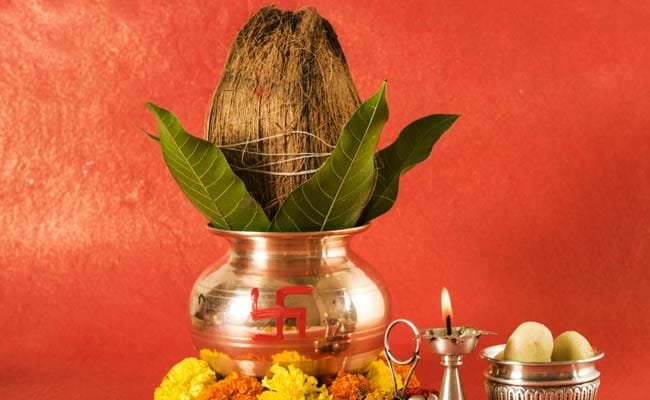In Hindu tradition, Kalash for Puja is very important. The significance of Kalash in Puja is representative of certain things. In the chapters of Hindu rites and rituals, the Kalash or pot plays a significant role. Believe it or not, without the presence of a Kalash or a pot, most of our rituals and pujas are incomplete. In the following excerpt, you would know Kalash meaning in a traditional sense and the reason behind doing so, and the beliefs that one associates with it.
Kalash Meaning And How Does One Fill It?
Before we proceed to its significance, let’s know the Kalash meaning. The Kalash is also known as Kumbh in certain parts of the country. It is a pot made of brass, copper, or clay that one can fill with water from seven rivers, seven wells, or seven seas. One can even fill the pot with water from any single source. Or one could fill it with unbroken grains of rice together with nine or eleven mango leaves surrounding a coconut kept on its top. One can even tie a red or white cotton thread around the pot in an intricate diamond-shaped pattern. Then one can decorate the pot with auspicious signs and designs. Then only a person can use Kalash for puja.
Kalash for Puja – Where Is it Placed?
While using Kalash for Puja, there are certain things that you need to keep in mind – the most important being the placement. A Kalash is kept with respect and regards to due Hindu rites and rituals. So for example, before all-important auspicious occasions like weddings, grihapravesh (the house-warming ceremony) and Navratri puja. People also use it ceremonially while receiving holy personages.
Sometimes, people also place the Kalash near the entrance of the house to welcome the guests. According to a few legends, before the world was created, Lord Vishnu lay reclining on his sheshanaga shaiyya or serpent bed in Ksheersagar or the milky ocean. Then once upon a time, came to a lotus from his navel and this lotus, Lord Brahma, the creator of this world, appears.
The Meaning It Represents – Significance of Kalash in Puja
The significance of Kalash in puja also lies in the meaning that it represents. The water in the Kalash symbolizes the primordial water from which Lord Brahma and the entire creation came into existence. The coconut fruit kept at its mouth represents the head of the devotee. Similarly, the mango leaves that are in a linear arrangement around the coconut are kept for a purpose. The reason is to attract divine vibrations from the astral world to bless the devotee. Not only this but to also make the water divine or the rice-filled in the Kalash.
Purnakalash
Rice is also filled in Kalash for puja. Do you know its significance? When one fills the rice in the Kalash, then one can term this as purnakalash. Also, the rice that is already in the pot is known as akshat or unbroken grains of rice. This symbolizes eternal blessings on the devotee as well as his family. The Akshay is the component that will not exhaust. And the rice has the unique quality of being able to absorb the negativity that is in the environment.
An Auspicious Association
The significance of Kalash for puja also lies in the fact that it is considered auspicious, therefore people worship it. While worshipping the Kalash, the blessings of all the seven rivers and deities, including those of Lord Vishnu, invokes. After the puja, its water is used for all the rituals, including the abhisheka or divine bath.
Kumbh Abhisheka
The consecration of an idol or a temple with the help of the Kalash is the name for Kumbh abhisheka. This wonderfully takes place with elaborate rituals and rites according to ancient times. It also. includes the pouring of holy water from one or more Kalash over the head of the idol or the Shikhar or dome of the temple. These are some of the reasons why people use the Kalash for puja.








